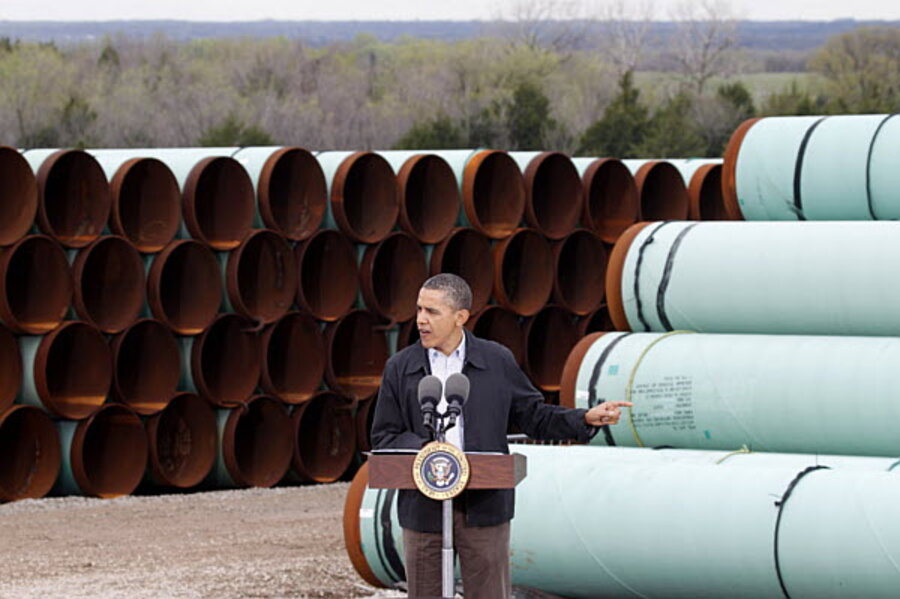Keystone XL pipeline: Did Obama just drop a big hint about his decision?
Loading...
| Washington
President Obama broke his silence on the Keystone XL pipeline Tuesday, saying that the controversial project should be approved only if it will not produce a net increase in greenhouse gas emissions.
The politically charged issue has hung over the Obama administration for years, as environmentalists have competed with energy interests and some labor unions for the president’s ear and public opinion. If approved by the State Department – and ultimately by the president – the pipeline would carry oil from the tar sands of Alberta, Canada, 1,200 miles to the Gulf of Mexico.
“Our national interest will be served only if this project does not significantly exacerbate the problem of carbon pollution,” Mr. Obama said in a major speech on climate change at Georgetown University. “The net effects of the pipeline's impact on our climate will be absolutely critical to determining whether this project is allowed to go forward.”
Obama did not provide specifics on how the environmental impact of the pipeline would be measured. A final decision on Keystone XL is not expected until later this year or early next year. Critics have charged that drilling in tar sands, and turning the extracted bitumen into crude oil, causes significant air and water pollution.
Obama has long described his energy policy as “all of the above” – leading many observers to conclude that he would eventually approve the pipeline, balanced with more renewable energy and stricter limits on carbon emissions from coal-fired plants.
But some environmentalists cheered Obama’s remarks yesterday, pointing to studies that show the pipeline would produce higher emissions, leading them to conclude that the president will ultimately reject Keystone XL. Others weren’t so sure, suggesting his language was sufficiently vague to leave him wiggle room to approve the project.
Bill McKibben, a leading voice among environmentalists and founder of the activist group 350.org, reacted positively.
"This is an appropriate standard that the president appears to be setting on Keystone XL,” Mr. McKibben said. “The president is saying what the science has always demanded. It's encouraging news for certain."
Another activist suggested that there’s no way the pipeline can pass Obama’s test – and therefore he can’t approve it.
“The president made it emphatic: He won't green light a tar sands pipeline that means more carbon pollution, more climate chaos, more drought, heat, fire, and floods,” said Susan Casey-Lefkowitz, director of the international program with the Natural Resources Defense Council.
But a leading Senate opponent of the pipeline, Sen. Bernie Sanders (I) of Vermont, sounded as if Obama’s statement meant he was planning to go ahead and approve the pipeline.
“The president must not give speeches about the dangers of global warming and then turn around and allow construction of the Keystone pipeline from Canada’s tar sands oil fields which would result in a huge increase in carbon emissions,” Senator Sanders said in a statement.
In a follow-up comment, Sanders’ spokesman said the standard that Obama referenced in his speech is one that a State Department report issued in March already claims would be met.
Obama is walking a political tightrope over Keystone XL. Though safely reelected, he still needs to keep his political base with him, lest his job approval ratings keep falling, reducing his clout. But elements of his base fall on both sides of the issue: Environmentalists fear for the pipeline’s impact on the global climate, while labor unions are eager for the jobs that the construction and maintenance of the pipeline would produce. And if Obama is seen as going too far to the left on energy and the environment, that could hurt vulnerable Senate Democrats running for reelection next year, and potentially jeopardizing Democratic control of the Senate.
One reason for rejecting the pipeline has diminished over time. Initially, the Republican governor of Nebraska opposed the project, saying it could endanger the water supplies in a major aquifer. When the owner, TransCanada, redrew the proposed route, the governor approved it.
Two portions of the Keystone pipeline system have already been constructed. Last year, Obama approved construction of the lower remaining portion, which runs from Cushing, Okla., to the Texas Gulf Coast. It’s the upper remaining portion that remains in limbo.








